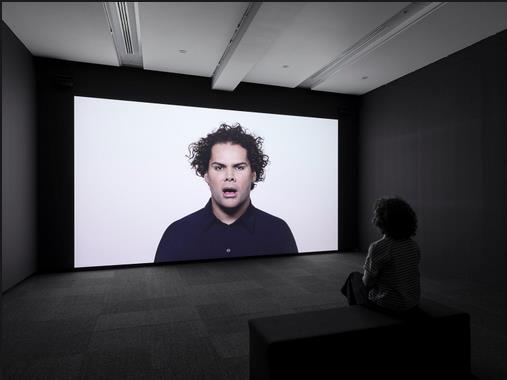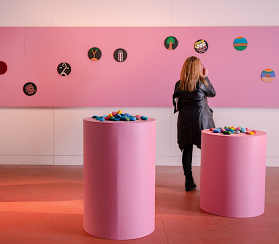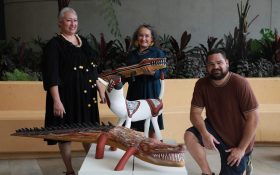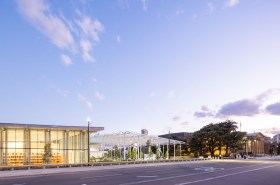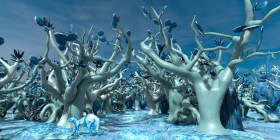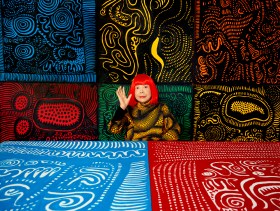Installation view, Christian Thompson’s Refuge (2014), shown here in Ritual Intimacy at Monash University Museum of Art. Currently presented at Lawrence Wilson Art Gallery in Love, Displaced (2019)
It is a brave move to present an all-video exhibition, especially when you consider audiences today and their ever shorter attention spans and demands for quick-bite entertainment.
Add to that the difficulty of presenting seven adjacent video works concurrently – managing equipment resources, sound bleed, gallery architecture, exhibition flow. It is a tough call, and few do it well.
Love, Displaced, presented by Lawrence Wilson Art Gallery for Perth Festival, is an incredibly cohesive and meticulously presented show. I need to salute the gallery’s team in superbly managing my pet hate – those sound bleeds – especially when considering such poignant and intimate narratives on screen.
To illustrate, I am talking about the journey from Jacobus Capone’s two channel work, Volta (2016) – of a man re-learning a father’s passion for the piano accordion – to Christian Thompson’s single channel work, Refuge (2014), where the artist sings of brotherly love in his native Bidjara language.
Music and memory connects these two, and yet the visitor experience of each is uninterrupted and contemplative.
Thompson sings to the camera, reaching out and visually connecting with the viewer; Capone’s two reversa-screens float in the space, the images on screen beautifully cropped and framed so that the narrative is told in poetic fragments, not dissimilar to the organic fragments of memory.
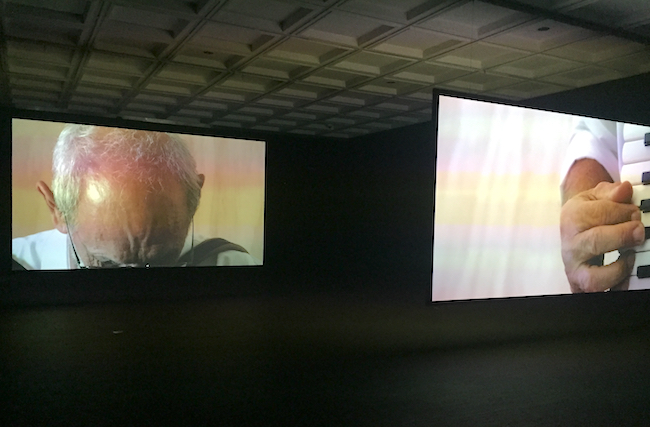
Installation view, Jacobus Capone’s two channel work, Volta (2016) in Love, Displaced at Lawrence Wilson Art Gallery (2019); photo ArtsHub
Curator Felicity Fenner said of the exhibition: ‘[It] reveals shared approaches to investigating romance and love in a hyper-self-conscious, media-saturated contemporary world’, going on to quote the author of the 2018 best seller Lost Connections, Johann Hari: ‘Loneliness hangs over our culture today like a thick smog.’
Fenner teases out these conversations further in a single-channel video piece by Richard Lewer, Never Shall Be Forgotten – A Mother’s Story (2017). This animation gives voice to the mother of John Pat, an Indigenous teenager from WA’s Pilbara region, ‘whose killing by police in 1983 was a flashpoint in race relations and is now seen as a symbol of injustice and oppression,’ explains Fenner.
It is a ‘hand-drawn from of social realism’ she added.
Social justice laced with humour is the recipe that Tracey Moffatt and Gary Hillberg have chosen for their montage work exploring racial “otherness”. Other (2010) splices together hundreds of Hollywood moments; screen perceptions of racial taboos and exoticisms in a gyrating, rhythmically-building display that soon reaches boiling point.
While this work has been widely exhibited, its inclusion in Love, Displaced marks its Perth debut.
Humour is also the tone that Israeli artist Roee Rosen has chosen for his 23-minute video work, The Dust Channel (2016). It uses an operatic genre – romantic tragedy – where a couple’s fear with dirt leads them to their love affair with a Dyson vacuum cleaner and obsession for home cleaning.
Move beyond the surface and this is a much darker narrative about removing “foreign objects” and attempted control over an overwhelming refugee situation.
Again, the use of music is a nice connection across this suite of video works.
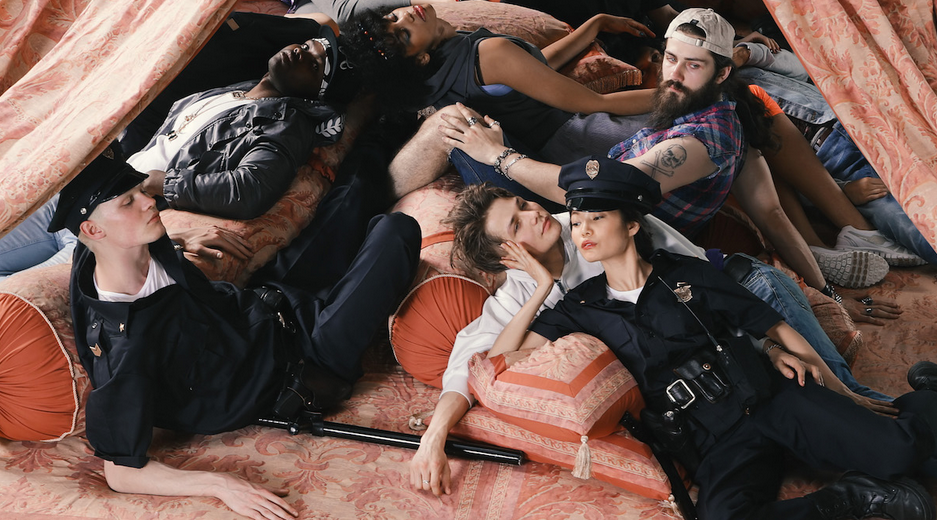
AES+F, Inverso Mundus, Still #1-18 (detail), 2015, pigment InkJet print on FineArt Baryta paper, 32×57.5 cm (12.5×22.7 in), edition of 10. Courtesy of AES+F and Anna Schwartz Gallery, Melbourne
Another high point in the exhibition, and offering a nice connection to the surreal delivery of Rosen’s work, is a single channel piece by Russian collective AES+F. Inversa Mundus (2015) takes its title from the Italian term meaning to reverse. They turn our contemporary world upside down – a pig slaughters a butcher, street-cleaner scatter the city with trash, beggars bestows alms on the rich, and policemen become thieves. Like Rosen’s work we are invited to dip deep beneath the surface narrative.
Love, Displayed is an example of how to do a video show well. These are not just isolated pieces to engage with briefly before moving on – a kind of lazy curatorial model when showing multiple videos, with each an individual kiosks of curiosity. Rather, as the viewer works through and across this exhibition, the connections are clear. It reminds us that we can still find empathy in our era of 21st century screen culture. It also reminds us that while we may be displaced in our contemporary lives, that art offers the through-lines to family, to memory and to meaningful connection.
And if that doesn’t catch punters, then the fact that these seven video works are all signature pieces by these artists, means that this exhibition is a must see for those seeking to get a grasp on contemporary screen practice today.
4 ½ stars: ★★★★☆
Love, Displaced
Lawrence Wilson Art Gallery
The University of Western Australia
9 February – 11 May 2019
Artists: AES+F (Russia), Jeremy Deller and Cecelia Bengolea (UK/Argentina/France), Richard Lewer (Australia), Jacobus Capone (Australia), Christian Thompson (Australia), Tracey Moffatt & Gary Hillberg (Australia), Roee Rosen (Israel).
